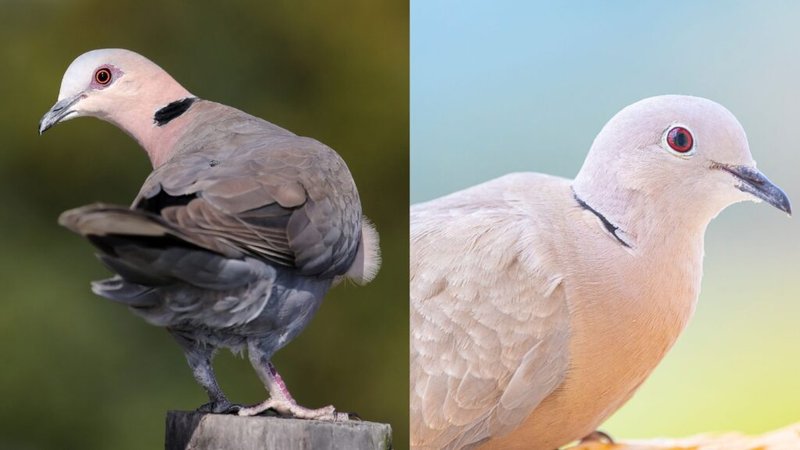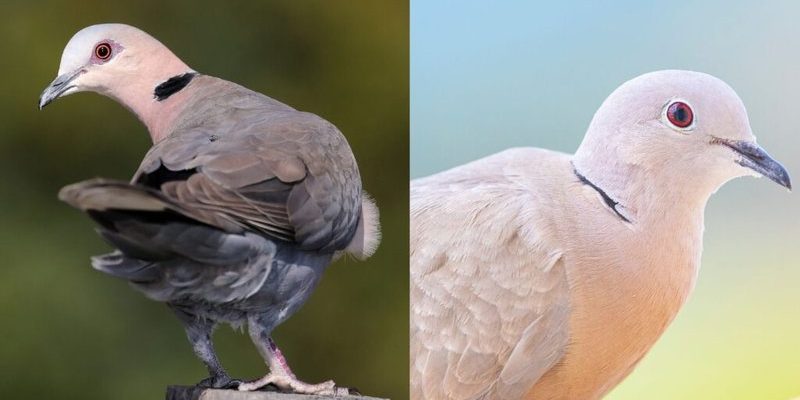
What is the Eurasian Collared Dove?
The Eurasian collared dove is a medium-sized bird known for its soft cooing sounds and elegant appearance. With its slate-gray color and distinctive black crescent or “collar” on its neck, this bird is hard to miss once you know what you’re looking for. It’s a social bird, often seen in pairs or small flocks, making it a common sight in urban gardens, parks, and rural areas.
Found originally in Europe and Asia, this species has expanded its range significantly and is now common in North America as well. You might be wondering how it got here—well, it was introduced to the Bahamas in the 1970s and has made its way north over the decades. Its adaptability and pleasant nature make it a welcome addition to various habitats.
Physical Features That Distinguish the Eurasian Collared Dove
One of the easiest ways to identify the Eurasian collared dove is through its physical features. Size and shape play a big role here. Unlike smaller doves that flit around, the collared dove is about 12 to 14 inches long, with a wingspan of roughly 18 to 22 inches. Its long, pointed tail and rounded body give it a sleek appearance.
In terms of color, the Eurasian collared dove is primarily light gray, which can sometimes be mistaken for other common doves. What really sets it apart is the black line that goes around its neck, forming a crescent shape. This collar is a crucial identifying trait. If you see a dove with this distinctive marking, you can confidently say you’re looking at a Eurasian collared dove rather than a mourning dove, which lacks this feature.
Behavioral Traits of the Eurasian Collared Dove
When it comes to behavior, the Eurasian collared dove has some unique habits. It’s known for its calm demeanor, often seen sitting quietly and occasionally fluffing its feathers. While they’re not as shy as some other dove species, they still prefer to keep a safe distance from potential threats.
These doves are also incredibly vocal. Their cooing sounds are a hallmark of their presence. If you hear a soft, repetitive coo, there’s a good chance you’ve stumbled upon a Eurasian collared dove. They have a distinct three-part call that’s pretty charming. Unlike other birds that may be more erratic in their songs, the collared dove’s call is more soothing and consistent, making them a delightful addition to any outdoor space.
Comparing the Eurasian Collared Dove to the Mourning Dove
Let’s talk about one of the Eurasian collared dove’s most common look-alikes: the mourning dove. At first glance, these two species might seem quite similar, but there are key differences that can help you tell them apart.
Mourning doves are generally a bit smaller, measuring about 9 to 13 inches long. Their color is lighter, often a tan or buff shade, lacking the gray tones of the collared dove. Instead of a black collar, mourning doves have a subtle bluish wash on their wings. If you pay attention to their calls, the mourning dove has a softer, melancholic tone, which is quite different from the collared dove’s more rhythmic coo.
Behaviorally, mourning doves tend to be quicker and more skittish. They often take off at the slightest disturbance, while the Eurasian collared dove remains more composed. If you want to spot both types in your backyard, keep an eye out for the more relaxed collared dove, often seen enjoying seeds alongside the faster-moving mourning dove.
Spotting the Eurasian Collared Dove in the Wild
If you’re eager to spot a Eurasian collared dove in the wild, there are a few tips to keep in mind. These birds generally prefer open spaces, so head to parks, gardens, or even neighborhoods with lots of trees and shrubs. They’re not afraid of people, which makes them easier to observe than some other bird species.
Look for them perched on wires or in trees, where they often like to survey their surroundings. They tend to feed on the ground, so you might catch them pecking at seeds or grains. Just remember to be quiet and patient—birds can be skittish, and sudden movements may send them flying.
Another fun way to observe them is during their mating season. Their courtship displays include a kind of fluttering flight, where they may rise and fall in the air. If you can catch this performance, you’ll appreciate their grace even more.
Conservation and the Future of the Eurasian Collared Dove
Fortunately, the Eurasian collared dove is not facing significant threats, making it a success story in the bird conservation world. Their adaptability has helped them thrive in various habitats, from suburban areas to wild landscapes. However, like all birds, they are still impacted by habitat loss and changes in agricultural practices.
It’s essential to create friendly environments for these birds. You can do this by planting native shrubs and providing food sources. If you have a garden, consider leaving out some seeds or grains to attract them. While they’re thriving now, every little effort to support wildlife can contribute to a more balanced ecosystem.
As you continue your birdwatching journey, keep an eye out for these charming birds. They’re not just another feathered friend; their unique traits and behaviors are a delightful reminder of the diversity of wildlife around us. By learning about the Eurasian collared dove, you can appreciate the intricate web of life that surrounds us.
In essence, recognizing the differences between the Eurasian collared dove and similar species can deepen your connection with nature. Whether you’re an avid birdwatcher or simply enjoy the beauty of wildlife, understanding these nuances makes each sighting more meaningful. So grab your binoculars and enjoy your next adventure in birdwatching!

